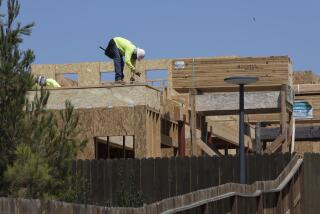Balancing El Toro Airport’s Costs, Benefits
- Share via
It is clear that a new commercial airport at El Toro will raise property values in Orange County. It is equally clear that a new commercial airport will lower property values for some homeowners in the noise footprint laid down by future commercial flights.
My research has shown that airports raise commercial values over a broad area; the commercial-values landscape has a peak at the airport and slopes away at a rate that depends on the transportation system in the region.
Given the focused impact of airport noise, it is clear that the costs are borne by a few and the benefits are spread over many commercial landowners and homeowners. The distribution of these benefits and costs is the central issue in the debate over the El Toro airport, and it has not been properly addressed by either side.
It is poor social policy to commit public funds to projects that benefit some while they harm others. To apply this principle to the El Toro airport, we must find a way to permit homeowners in the environmentally impacted areas to gain even as the rest of the county property owners and residents gain. This is not a difficult problem to solve.
Suppose the airport were proposed as a private venture. Would anyone permit it to go forward in the face of uncompensated damages to the residents near the airport? I think not.
So that there will be no losers, the new airport has to pay for the noise impact over and above what was associated with the military base.
A future El Toro airport could do this by purchasing noise easements on the land, paying the homeowners a monthly fee for the noise it inflicts on their property. Or the airport operator could purchase the property within the noise zone and lease the homes back to the previous owners or to other, less noise-sensitive individuals. Similarly, the road system should be designed so that residents suffer no additional travel burdens.
One way to charge the beneficiaries and compensate the losers is to set up a special tax district in the environs of the airport. Charge nonresidential properties within the district a tax premium (since they gain in value) and grant homeowners within the district a generous residential tax rebate. The revenue generated from the premium commercial tax assessments would be more than enough to compensate noise-impacted homeowners.
Instead of a tax credit, the El Toro airport could levy an environmental fee on each passenger or airline takeoff and landing. If the airport needed to expand operations that make more noise, it would have to buy additional noise easements. Or the airport operator would have to buy perpetual easements sufficient to accommodate future expansion.
Whether the El Toro airport creates a special tax district, pays a noise fee or buys the noise-impacted properties, the tax credit or payment should more than adequately compensate homeowners for their lost value. A homeowner who sees and hears an aircraft moving overhead as a noise fee payment to his account rather than a taking of property will have a more friendly attitude about the El Toro airport (or any future airport, for that matter). And the ability of the airport to pay the full social cost of its impact will be a test of whether it should be built.
More to Read
Inside the business of entertainment
The Wide Shot brings you news, analysis and insights on everything from streaming wars to production — and what it all means for the future.
You may occasionally receive promotional content from the Los Angeles Times.










